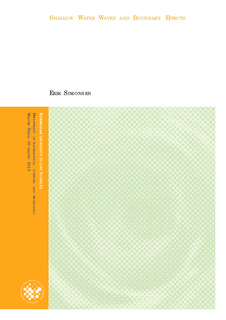| dc.contributor.author | Simonsen, Erik | |
| dc.date.accessioned | 2013-08-07T10:42:11Z | |
| dc.date.available | 2013-08-07T10:42:11Z | |
| dc.date.copyright | 2013 | |
| dc.date.issued | 2013-08-07 | |
| dc.identifier.uri | http://hdl.handle.net/11250/188963 | |
| dc.description.abstract | This thesis is written in cooperation with Nexans Norway AS and evaluates wave theories applied in calculations of wave loads on submarine structures. Nexans Norway AS has provided metocean and soil data from an on-going British Petroleum project outside the coast of Egypt that is used as a case study. This thesis aim to investigate the range of validity for the linear Airy theory in shallow and transitional waters. The Airy theory is a simple and frequently used wave theory in coastal engineering to approximate the wave kinematics. To evaluate the Airy theory’s validity and accuracy in shallow and transitional water depths, the theory is used to calculate the particle velocity 0.5 meter above seabed in these water depths. Stokes 2nd order wave theory is a non-linear expansion of the Airy theory and is also included in the calculations. The results from both wave theories are evaluated and compared with results from the numerical stream function theory. The results of the particle velocity calculations indicate significant differences between the Airy theory and the stream function theory for shallow and transitional water depths. Stokes 2nd order wave theory provides overall better results than the Airy theory in comparison with the results from the stream function theory, especially for the shallowest water depths included in the study. A research study of boundary layer effects close to the seabed is carried out in the thesis. Stokes oscillating boundary layer theory is described in detail and equations from the theory is derived with variable viscosity. Padé approximants are used to approximate the variable viscosity function. The results indicate that the boundary layer affects the velocity profile. The boundary layer thickness is shown to increase with increasing viscosity. In this thesis, only an introduction to sediment transport theory is carried out. To get a full evaluation of the boundary layer effects on the wave flow, further work is recommended to include sediment transport in the calculations wave flow in the boundary layer. | no_NO |
| dc.description.sponsorship | Nexans Norway AS | no_NO |
| dc.language.iso | eng | no_NO |
| dc.publisher | Norwegian University of Life Sciences, Ås | |
| dc.subject | Fluid dynamics | no_NO |
| dc.subject | Water waves | no_NO |
| dc.title | Shallow water waves and boundary effects | no_NO |
| dc.type | Master thesis | no_NO |
| dc.subject.nsi | VDP::Technology: 500::Marine technology: 580::Offshore technology: 581 | no_NO |
| dc.source.pagenumber | 76 | no_NO |
